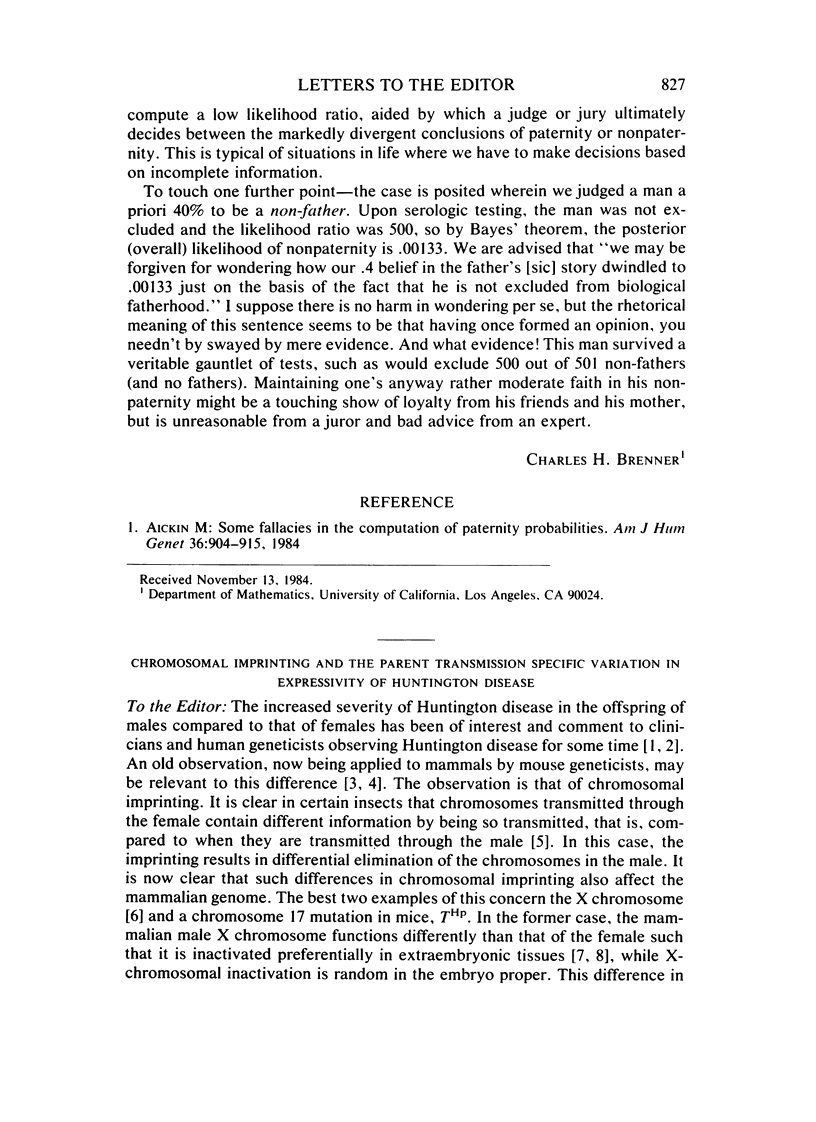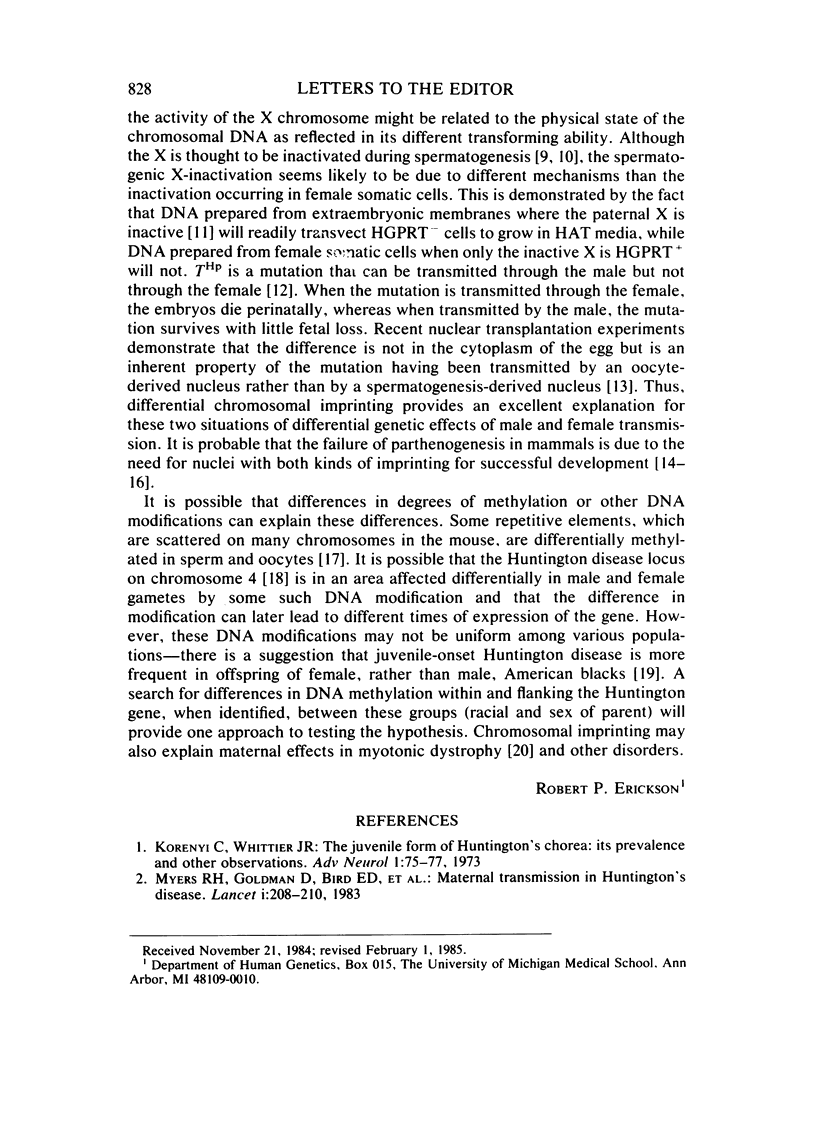Full text
PDF


Selected References
These references are in PubMed. This may not be the complete list of references from this article.
- Chandra H. S., Brown S. W. Chromosome imprinting and the mammalian X chromosome. Nature. 1975 Jan 17;253(5488):165–168. doi: 10.1038/253165a0. [DOI] [PubMed] [Google Scholar]
- Crouse H V. The Controlling Element in Sex Chromosome Behavior in Sciara. Genetics. 1960 Oct;45(10):1429–1443. doi: 10.1093/genetics/45.10.1429. [DOI] [PMC free article] [PubMed] [Google Scholar]
- Erickson R. P. Glucose-6-phosphate dehydrogenase activity changes during spermatogenesis: possible relevance to X-chromosome inactivation. Dev Biol. 1976 Oct 1;53(1):134–137. doi: 10.1016/0012-1606(76)90216-5. [DOI] [PubMed] [Google Scholar]
- Falconer D. S., Isaacson J. H., Gauld I. K. Non-random X-chromosome inactivation in the mouse: difference of reaction to imprinting. Genet Res. 1982 Jun;39(3):237–259. doi: 10.1017/s0016672300020930. [DOI] [PubMed] [Google Scholar]
- Gusella J. F., Wexler N. S., Conneally P. M., Naylor S. L., Anderson M. A., Tanzi R. E., Watkins P. C., Ottina K., Wallace M. R., Sakaguchi A. Y. A polymorphic DNA marker genetically linked to Huntington's disease. Nature. 1983 Nov 17;306(5940):234–238. doi: 10.1038/306234a0. [DOI] [PubMed] [Google Scholar]
- Johnson D. R. Further observations on the haipin-tail (Thp) mutation in the mouse. Genet Res. 1974 Oct;24(2):207–213. doi: 10.1017/s0016672300015226. [DOI] [PubMed] [Google Scholar]
- Kratzer P. G., Chapman V. M., Lambert H., Evans R. E., Liskay R. M. Differences in the DNA of the inactive X chromosomes of fetal and extraembryonic tissues of mice. Cell. 1983 May;33(1):37–42. doi: 10.1016/0092-8674(83)90332-x. [DOI] [PubMed] [Google Scholar]
- Lifschytz E., Lindsley D. L. The role of X-chromosome inactivation during spermatogenesis (Drosophila-allocycly-chromosome evolution-male sterility-dosage compensation). Proc Natl Acad Sci U S A. 1972 Jan;69(1):182–186. doi: 10.1073/pnas.69.1.182. [DOI] [PMC free article] [PubMed] [Google Scholar]
- Lyon M. F., Rastan S. Parental source of chromosome imprinting and its relevance for X chromosome inactivation. Differentiation. 1984;26(1):63–67. doi: 10.1111/j.1432-0436.1984.tb01375.x. [DOI] [PubMed] [Google Scholar]
- Mann J. R., Lovell-Badge R. H. Inviability of parthenogenones is determined by pronuclei, not egg cytoplasm. Nature. 1984 Jul 5;310(5972):66–67. doi: 10.1038/310066a0. [DOI] [PubMed] [Google Scholar]
- McGrath J., Solter D. Completion of mouse embryogenesis requires both the maternal and paternal genomes. Cell. 1984 May;37(1):179–183. doi: 10.1016/0092-8674(84)90313-1. [DOI] [PubMed] [Google Scholar]
- McGrath J., Solter D. Maternal Thp lethality in the mouse is a nuclear, not cytoplasmic, defect. Nature. 1984 Apr 5;308(5959):550–551. doi: 10.1038/308550a0. [DOI] [PubMed] [Google Scholar]
- Myers R. H., Goldman D., Bird E. D., Sax D. S., Merril C. R., Schoenfeld M., Wolf P. A. Maternal transmission in Huntington's disease. Lancet. 1983 Jan 29;1(8318):208–210. doi: 10.1016/s0140-6736(83)92587-4. [DOI] [PubMed] [Google Scholar]
- Sanford J., Forrester L., Chapman V., Chandley A., Hastie N. Methylation patterns of repetitive DNA sequences in germ cells of Mus musculus. Nucleic Acids Res. 1984 Mar 26;12(6):2823–2836. doi: 10.1093/nar/12.6.2823. [DOI] [PMC free article] [PubMed] [Google Scholar]
- Surani M. A., Barton S. C., Norris M. L. Development of reconstituted mouse eggs suggests imprinting of the genome during gametogenesis. Nature. 1984 Apr 5;308(5959):548–550. doi: 10.1038/308548a0. [DOI] [PubMed] [Google Scholar]
- Takagi N., Sasaki M. Preferential inactivation of the paternally derived X chromosome in the extraembryonic membranes of the mouse. Nature. 1975 Aug 21;256(5519):640–642. doi: 10.1038/256640a0. [DOI] [PubMed] [Google Scholar]
- West J. D., Frels W. I., Chapman V. M., Papaioannou V. E. Preferential expression of the maternally derived X chromosome in the mouse yolk sac. Cell. 1977 Dec;12(4):873–882. doi: 10.1016/0092-8674(77)90151-9. [DOI] [PubMed] [Google Scholar]
- Zellweger H., Ionasescu V. Early onset of myotonic dystrophy in infants. Am J Dis Child. 1973 Apr;125(4):601–604. doi: 10.1001/archpedi.1973.04160040097021. [DOI] [PubMed] [Google Scholar]


